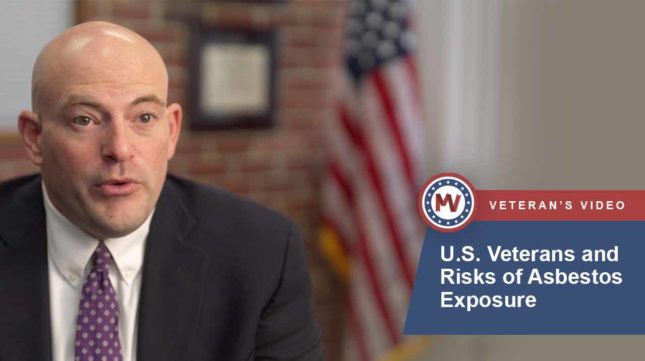Asbestos has been linked to mesothelioma and other cancers. Millions of people — including many U.S. veterans — were exposed to asbestos. Today, veterans with asbestos-caused cancers may be able to get medical care and benefits from the U.S. Department of Veterans Affairs (VA), as well as private compensation.
How Does Asbestos Cause Cancer?

Asbestos exposure has been linked to higher cancer risk for decades. Asbestos is a highly durable mineral made up of microscopic fibers. Between the 1930s and early 1980s, asbestos-based insulation, roofing, and flooring materials were widely used by the U.S. military and in dozens of industries.
Manufacturers of products containing asbestos knew their goods could cause a variety of cancers as far back as the 1930s. However, they hid the truth to keep making money.
If someone disturbs an asbestos-based product, tiny fibers can enter the air and be inhaled or swallowed without notice. These fibers then get embedded into different parts of the body. They can't be broken down because they are so durable.
Over time, the DNA of healthy cells is damaged by the asbestos fibers. This causes healthy cells to become cancerous and divide uncontrollably.
Someone exposed to asbestos may develop:
- Mesothelioma
- Colorectal cancer
- Laryngeal cancer
- Lung cancer
- Ovarian cancer
- Stomach cancer
Video Summary: In this video, VA-accredited attorney Eric Hall explains why U.S. veterans are at risk of asbestos-related diseases like mesothelioma. He also breaks down how affected veterans can access military benefits and medical treatment. Call (877) 450-8973 to get started. View Transcript
Veterans who served in the military between the 1930s and the 1980s were likely exposed to asbestos while they were on active duty. Usually, if you've developed an asbestos-related disease, you developed that disease because you had an excessive amount of exposure to asbestos.
If a veteran believes they were exposed to asbestos while serving in the military, we encourage them to call the Mesothelioma Veterans Center so that we can work together to help them file for VA benefits.
The VA will recognize any asbestos-related disease as long as your asbestos exposure happened while you were on active duty in the military.
In addition to VA benefits, the Mesothelioma Veterans Center can connect veterans with world-renowned physicians and nurses on staff that can answer any of your treatment questions. We encourage veterans to call and find out how we can help them.
Every year, thousands of people are diagnosed with mesothelioma and other asbestos-related diseases. Anyone exposed to asbestos could develop cancer. However, those who worked around asbestos on a regular basis and faced occupational exposure — including U.S. veterans — have an increased risk.
Thankfully, veterans with cancer caused by asbestos exposure may be able to pursue VA benefits and legal compensation.
What Kinds of Cancer Does Asbestos Cause?
Many different types of cancer have been linked to the asbestos. These asbestos-caused cancers are detailed below.
Mesothelioma
Malignant mesothelioma is a highly aggressive and rare cancer that develops in the mesothelium (the lining of the lungs, abdomen, heart, and testes). Asbestos is the only known cause of mesothelioma.
There are 4 types of mesothelioma:
- Pleural mesothelioma, which forms in the lining of the lungs (pleura) and is the most common type
- Peritoneal mesothelioma, which affects the lining of the abdomen and is the most treatable type
- Pericardial mesothelioma, which affects the lining of the heart and is very rare
- Testicular mesothelioma, which forms in the lining of the testes and is the rarest of all four types
Approximately 3,000 people are diagnosed with mesothelioma each year. Since the military relied on asbestos to make bases, ships, and vehicles until the early 1980s, around 33% of those diagnosed are U.S. veterans.
Lung Cancer
While pleural mesothelioma affects the lining of the lungs specifically, veterans can also develop lung cancer from asbestos exposure. Asbestos fibers can get lodged in lung tissue and eventually cause cancer.
Lung cancer is the third-most common form of cancer, according to the National Cancer Institute (NCI). While it has many causes, the Environmental Working Group (EWG) found that asbestos-related lung cancer kills 8,500-10,000 people each year.
Smokers exposed to asbestos on a regular basis have a higher risk of getting this cancer, according to the American Cancer Society (ACS). This is because both tobacco smoke and asbestos contain carcinogens that lead to lung cancer.
Gastrointestinal Cancer
Exposure to asbestos-containing materials may cause cancer in the gastrointestinal organs. Common types of gastrointestinal cancers linked to asbestos include colon cancer, rectal cancer, and stomach cancer.
Colon Cancer
Recent reports have found that asbestos exposure increases the risk of colon cancer.
A study published in the journal Environmental Health Perspectives found that colon cancer was “significantly associated” with high rates of asbestos exposure among workers.
Past studies have also recovered asbestos fibers from the colon through biopsies (fluid/tissue samples) of people exposed to asbestos.
Additionally, in 2014, the VA granted benefits to a veteran on appeal after it was concluded that he developed colon cancer from military asbestos exposure.
Rectal Cancer
Rectal cancer is closely related to colon cancer since the two organs are connected within the intestinal system. Studies have noted an increased risk of colorectal cancer among those exposed to asbestos. “Colorectal” is an umbrella term referring to both the colon and the rectum.
Stomach Cancer
If asbestos fibers are swallowed, they may end up in the stomach and become stuck there. A cross-analysis of 36 studies found that asbestos exposure could possibly lead to stomach cancer.
“It is plausible that asbestos fibers could accumulate at sites of mucosal injury and ulceration in the stomach, but the extent to which this occurs in exposed persons has not been investigated.”
– The National Academy of Medicine
File for VA benefits now if you developed an asbestos-related cancer after serving in the military.
Ovarian Cancer
Asbestos can greatly harm the ovaries and cause cancer. Asbestos has been clearly linked to ovarian cancer through numerous studies and mounting lawsuits against the company Johnson & Johnson (J&J).
For decades, J&J made its world-famous baby powder from talc, a mineral often found near asbestos in natural rock deposits. Though talc on its own is generally safe, many talc deposits have been contaminated with asbestos fibers.
Recently unearthed company studies and records revealed that J&J found asbestos fibers in its baby powder multiple times, but suppressed the truth. The company first discovered asbestos in its powder back in 1957.
Many women who used the powder as a feminine hygiene product were diagnosed with ovarian cancer decades later, according to recent lawsuits. In fact, 22 women with ovarian cancer were awarded a $4.69 billion verdict in July 2018 after a jury found that their cancer was connected to J&J talcum powder.
As of 2023, J&J has stopped selling talc-based baby powder. The company stated that "misinformation" from the recent lawsuits led to low sales, which greatly influenced the decision.
Throat Cancer
The National Academy of Medicine (NAM) has confirmed that asbestos may cause laryngeal cancer, which affects the voice box. More research is needed to see if asbestos exposure increases the risk of other throat cancers.
“For cancer of the throat, the link is strongest for the hypopharynx, the part of the throat closest to the larynx (voice box). It’s not clear exactly how asbestos might affect risk for these cancers, but swallowed asbestos fibers might somehow contribute to the risk.”
– The American Cancer Society
What Are the Chances of Getting Cancer From Asbestos?
The Environmental Working Group (EWG) estimates that roughly 160,000-200,000 people died from asbestos-related lung cancer and mesothelioma between 1999 and 2013. Not everyone exposed to asbestos will develop cancer, however.
“People who become ill from asbestos are usually those who are exposed to it on a regular basis, most often in a job where they work directly with the material or through substantial environmental contact.”
– National Institutes of Health
Although the odds of developing an asbestos-related disease increase with more exposure, there’s no safe level of exposure to asbestos.
Risk Factors for Asbestos-Caused Cancers
There are several risk factors that may increase your chance of getting asbestos cancer.
These factors include:
- Gene mutations: Researchers believe that some patients with gene mutations are more likely to develop asbestos-related cancers. These mutations could be caused by radiation, viruses, or genetic variation at birth.
- Male gender: Many who develop cancer caused by asbestos — particularly mesothelioma — are male. Asbestos exposure was common in historically male-dominated professions like construction work and military service.
- Older age: Most people who develop asbestos-related cancers are 65 or older. This is because it takes 10-50 years for asbestos diseases to appear after exposure.
- Smoking: This is a risk factor tied specifically to lung cancer. The ACS noted that smokers with asbestos exposure have a higher risk of lung cancer than non-smokers with exposure.
It is also believed that poor nutrition, a sedentary lifestyle, and stress may also increase the risk of asbestos-related cancers.
Asbestos Cancers and Occupations
Occupational asbestos exposure happened all the time, and workers were exposed without knowing the risks since manufacturers hid the truth for decades.
About 50% of all occupational cancers are related to asbestos exposure, According to the World Health Organization (WHO).
There are many lines of work that could expose workers to carcinogenic substances like asbestos. People who worked directly with asbestos — such as shipyard workers, mechanics, and pipefitters — are at the highest risk of developing cancer as a result of their prolonged exposure.
U.S. veterans who served between the 1930s and early 1980s also have a higher risk due to widespread asbestos use in the U.S. Armed Forces. The material was used in large amounts to make military bases, vehicles, and ships.
Learn how you can get help if you developed an asbestos-related disease from serving in the military or working at a civilian job. Get our Free Veterans Packet now.
Symptoms of Asbestos Cancer
Asbestos cancers usually have vague symptoms that are shared with noncancerous illnesses. For example, symptoms of mesothelioma may be confused with pneumonia or asbestosis (a noncancerous lung disease caused by asbestos exposure).
Symptoms of lung cancer, laryngeal cancer, and mesothelioma include:
- Chest pain
- Coughing up blood
- Dry cough
- Pain in the ribs
- Pleural effusion (fluid buildup in the lung lining)
- Problems breathing
- Shortness of breath
- Shoulder pain
- Upper back pain
Common symptoms of abdominal asbestos cancers are:
- Abdominal pain
- Bloody stool
- Blood in vomit
- Changes in bowel function
- Fluid accumulation in the abdomen
- Nausea
- Problems with digestion
- Vomiting
- Weight loss
If a woman has ovarian cancer, symptoms may include:
- Back pain
- Bloating
- Weight gain
- Tiredness or exhaustion
Treatment of Asbestos Cancers
If you think you have cancer related to asbestos exposure, the best first step is to locate a specialized oncologist (cancer doctor) who can help properly diagnose and treat you.
Because the symptoms are often vague, diagnosing mesothelioma or other cancers caused by asbestos may be difficult. Oncologists may order imaging scans of the affected area to see if cancerous tumors have formed.
Common tests used to diagnose asbestos cancers are:
- CT scans
- PET scans
- X-rays
If imaging tests show any abnormality, your doctor will likely take a biopsy, which is a sample of fluid or tissue from the potentially cancerous area. A pathologist examines the sample under a microscope to confirm if there are cancer cells present.
After the diagnosis, your health care team will create a treatment plan. Surgery, radiation, and/or chemotherapy are commonly used treatments for mesothelioma. Many other cancers will also be treated with one or more of these same methods.
Some cancers are also treated with immunotherapy. This treatment enhances the immune system to attack cancerous cells.
File for asbestos VA benefits now to get top medical care and financial aid for mesothelioma and other asbestos-caused cancers.
Next Steps for People With Asbestos Cancer
Asbestos-related cancer remains a public health crisis. If you or a loved one developed mesothelioma or another cancer from asbestos exposure, get in touch with our team now. Our Patient Advocates can help you navigate life after a diagnosis and get benefits without any extra stress.
Our team can assist with:
- Filing a VA benefits claim
- Pursuing compensation from the makers of asbestos products
- Getting justice and peace of mind
VA benefits and compensation can help you and your family for years to come. File for VA benefits now.
FAQs About Asbestos and Cancer
What cancers are caused by asbestos?
Many cancers can be caused by asbestos exposure. Mesothelioma is the most notable cancer as asbestos is the only substance known to cause it.
That said, asbestos can cause many other cancers too, including ovarian cancer, lung cancer, and colorectal cancer.
Medical care and financial aid are available if you've been diagnosed with any of these asbestos-caused cancers.
What are the chances of getting cancer from asbestos?
The incidence of asbestos-related cancers is not 100%. In other words, not everyone exposed to asbestos will get cancer.
At this time, it's not known exactly why some people exposed to asbestos develop cancer and others don't. That said, those who worked with asbestos-containing products regularly at their job or while serving in the military are at a higher risk.
Since the health effects of asbestos — specifically, why some get cancer and others don’t — are still being studied, it’s a good idea to stay away from this deadly substance at all costs.
How long does it take to develop cancer from asbestos?
It typically takes 10-50 years to develop asbestos-related cancers. Once inhaled or swallowed, asbestos fibers get stuck in the body and are so durable that they can't be removed or broken down.
The fibers then irritate nearby healthy tissue for decades, leading to scarring and, sometimes, cell mutations that cause cancer.



